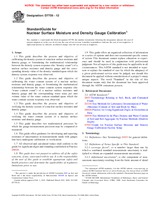Potřebujeme váš souhlas k využití jednotlivých dat, aby se vám mimo jiné mohly ukazovat informace týkající se vašich zájmů. Souhlas udělíte kliknutím na tlačítko „OK“.
ASTM D7759-12
Standard Guide for Nuclear Surface Moisture and Density Gauge Calibration
Automaticky přeložený název:
Standardní Příručka pro jadernou povrchové vlhkosti a hustota Gauge kalibrace
NORMA vydána dne 1.2.2012
Informace o normě:
Označení normy: ASTM D7759-12
Poznámka: NEPLATNÁ
Datum vydání normy: 1.2.2012
Kód zboží: NS-39075
Počet stran: 13
Přibližná hmotnost: 39 g (0.09 liber)
Země: Americká technická norma
Kategorie: Technické normy ASTM
Anotace textu normy ASTM D7759-12 :
Keywords:
calibration, calibration block, calibration constants, calibration curve, calibration standard, curve fit, gauge, in-place density, nuclear gauge, uncertainty, verification, water content, water mass per unit volume, ICS Number Code 17.040.30 (Measuring instruments)
Doplňující informace
| Significance and Use | ||||||||||
|
Gauge calibration is performed for the following purposes: To formulate a mathematical equation, or density calibration equation, that relates the gauge density system response (the “density count”) to the soil-equivalent density of the standard on which this response is elicited. To formulate a mathematical equation, or water content calibration equation, that relates the gauge water content system response (the “water content count”) to the water mass per unit volume value of the standard on which this response is elicited. To ensure that the gauge has an in-place water mass per unit volume gauge precision level that is consistent with typical gauge response. Gauge verification is performed for the following purposes: To indicate to the party or agency performing the verification when the mathematical relationship between the in-place density reading indicated by the gauge and the corresponding gauge density test count needs to be adjusted so that the gauge calibration meets the required level of measurement uncertainty. To indicate to the party or agency performing the verification when the mathematical relationship between the water mass per unit volume indicated by the gauge and the corresponding gauge water content test count needs to be adjusted so that the gauge calibration meets the required level of measurement uncertainty. Gauge verification and calibration require specialized training and equipment. Gauge calibration and verification should only be conducted by those trained in the proper operation of the gauge, the calibration or verification standards, and any tables, charts, graphs, or computer programs required for the proper execution of these operations. |
||||||||||
| 1. Scope | ||||||||||
|
1.1 This guide describes the process and objective of calibrating the density system of a nuclear surface moisture and density gauge, or formulating the mathematical relationship between the density system response (the “density count”) of a nuclear surface moisture and density gauge and the corresponding density value of the density standard upon which the density system response was observed. 1.2 This guide describes the process and objective of calibrating the water content system of a nuclear surface moisture and density gauge, or formulating the mathematical relationship between the water content system response (the “water content count”) of a nuclear surface moisture and density gauge and the corresponding water mass per unit volume value of the water content standard upon which the water content system response was observed. 1.3 This guide describes the process and objective of verifying the density system of a nuclear surface moisture and density gauge. 1.4 This guide describes the process and objective of verifying the water content system of a nuclear surface moisture and density gauge. 1.5 This guide describes two mathematical processes by which the gauge measurement precision may be computed or measured. 1.6 This guide offers guidance for developing and reporting estimates of uncertainties in measurements made with gauges that have undergone calibration or verification. 1.7 All observed and calculated values shall confirm to the guide for significant digits and rounding established in Practice D6026. 1.8 This guide does not purport to address all of the safety concerns, if any, associated with its use. It is the responsibility of the user of this guide to establish appropriate safety and health practices and determine the applicability of regulatory limitations prior to use. 1.9 This guide offers an organized collection of information or a series of options and does not recommend specific course of action. This document cannot replace education or experience and should be used in conjunction with professional judgment. Not all aspects of this guide may be applicable in all circumstances. This ASTM standard is not intended to represent or replace the standard of care by which the adequacy of a given professional service must be judged, nor should this document be applied without consideration of a project’s many unique aspects. The word “Standard” in the title of this document means only that the document has been approved through the ASTM consensus process. |
||||||||||
| 2. Referenced Documents | ||||||||||
|




 Cookies
Cookies
